The Zsolnay Porcelain Factory, located in Pécs, Hungary, is a treasure trove of artistry, innovation, and heritage. With a rich history dating back to the 19th century, the factory has become synonymous with the finest Hungarian ceramics. Over the years, it has produced a wide range of decorative and utilitarian objects, which showcase the creativity and expertise of its designers and craftsmen. The Zsolnay name has become a symbol of Hungarian cultural identity and a testament to the nation’s incredible artistic legacy. 170 years after its creation the factory is still producing wares. We take a look at the history of the Zsolnay factory and we take a particular look at some of their striking eosin glaze designs.
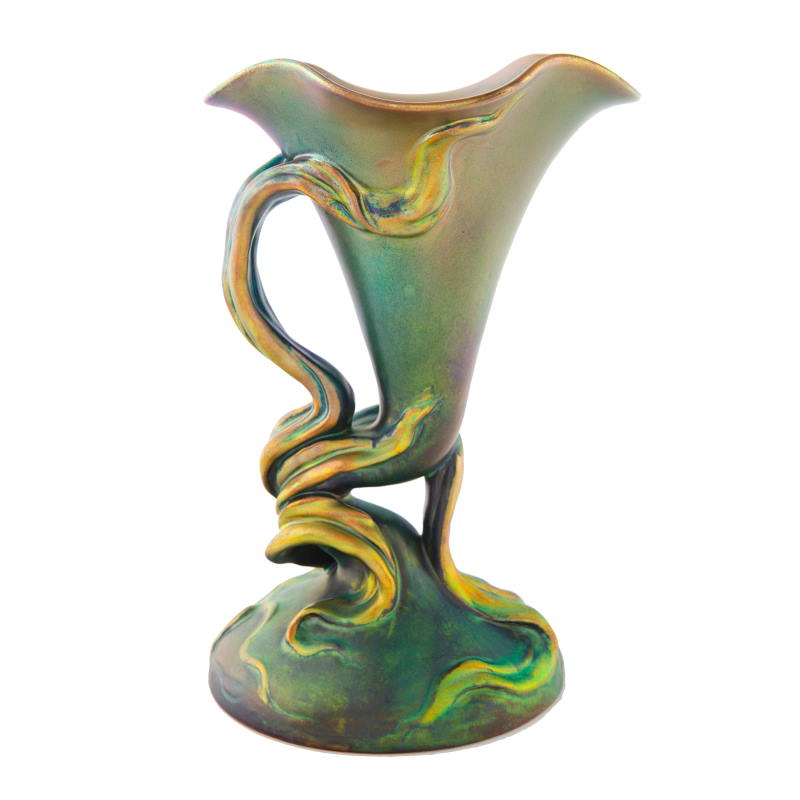
The Zsolnay Porcelain Factory was founded in 1853 by Miklós Zsolnay, an entrepreneur with a passion for ceramics. Initially, the factory produced stoneware and earthenware products, but the company’s fortunes changed when Miklós’ son, Vilmos Zsolnay, took over the business in 1863. Under Vilmos’ leadership, the factory shifted its focus to artistic ceramics and began experimenting with innovative glazes and techniques. By the late 19th century, the Zsolnay name had become synonymous with high-quality art pottery, and its products were highly sought after across Europe and beyond.
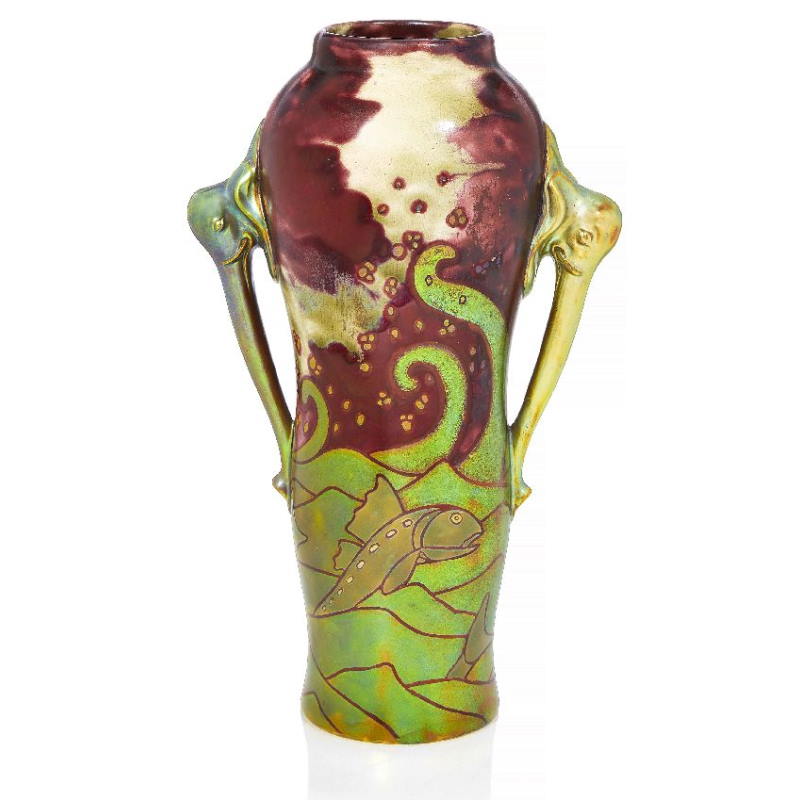
Throughout its history, the Zsolnay Ceramics Factory has collaborated with numerous artists and designers to create its signature pieces. Some notable designers include Tádé Sikorski, Sándor Apáti Abt, and József Rippl-Rónai. These talented individuals not only contributed to the development of the company’s unique aesthetic but also helped to establish its reputation as a leader in artistic ceramics.
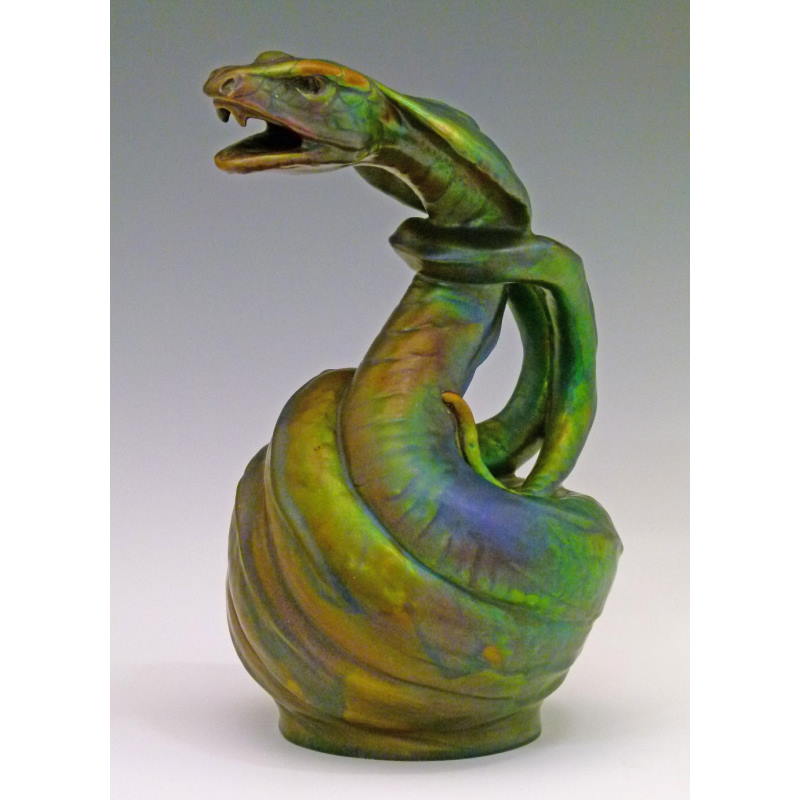
One of the most distinctive features of Zsolnay ceramics is the innovative Eosin (Eozin) glaze, which was developed in the 1890s by Vilmos Zsolnay and his chemist brother, Ignác. This iridescent glaze contains a mixture of metal oxides and is characterized by its ability to change color depending on the angle of light. The Eosin glaze has become a hallmark of Zsolnay ceramics, lending a captivating, otherworldly beauty to its creations. The Zsolnay Factory continues to create Eozin glaze products today.
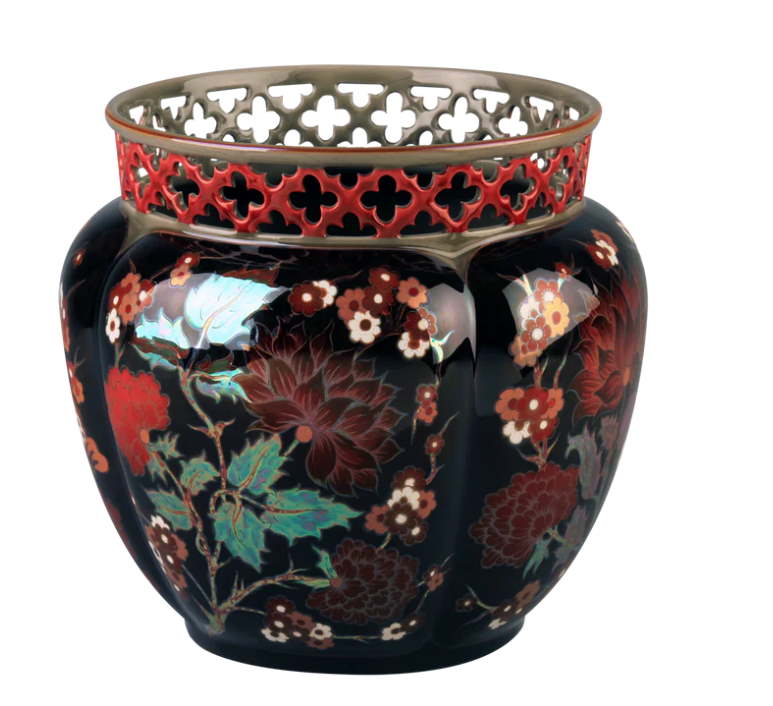
In addition to the Eosin glaze, the Zsolnay Ceramics Factory is known for its use of various other techniques, such as underglaze painting, polychrome decoration, and slip casting. These techniques have allowed Zsolnay to create an incredible array of textures, patterns, and colors in its pieces, which range from delicate to bold and from traditional to avant-garde.
In 1893 Vilmos Zsolnay introduced Eozin, a rich, iridescent glazing technique. The term, named after the Greek goddes Eos, goddess of dawn, was used to describe this unique finish. This technique became a trademark of Zsolnay and a favorite of art nouveau artists. The technique is a well-kept secret of the manufacture and its magical appearance has captivated collectors all over the world since it was first presented.
The Zsolnay Ceramics Factory produced a diverse range of ceramics, including decorative art objects, architectural ceramics, and utilitarian items. Some examples of their creations include:
- Decorative Art Objects
The late 19th and early 20th century saw a great deal of innovation and experimentation in the design and form of vases. Some of the most popular forms included tall, slender vases with flared or trumpet-shaped openings, as well as bulbous or rounded vases with wider, more open mouths. Designs ranged from simple, elegant shapes to intricate and ornate patterns, often featuring elaborate floral or geometric motifs. Many of these designs were influenced by the Art Nouveau movement, which was characterized by its use of flowing, organic lines and naturalistic motifs.The Zsolnay factory was known for its innovative and unique designs, and the company was no stranger to creating natural and animal-inspired vases. One example of this is the “peacock vase,” which was designed by Vilmos Zsolnay in the late 1800s. This vase was shaped like a peacock with its feathers fanned out to form the body of the vase. The feathers were highly detailed and featured intricate designs in a range of colors, including the famous eosin glaze.
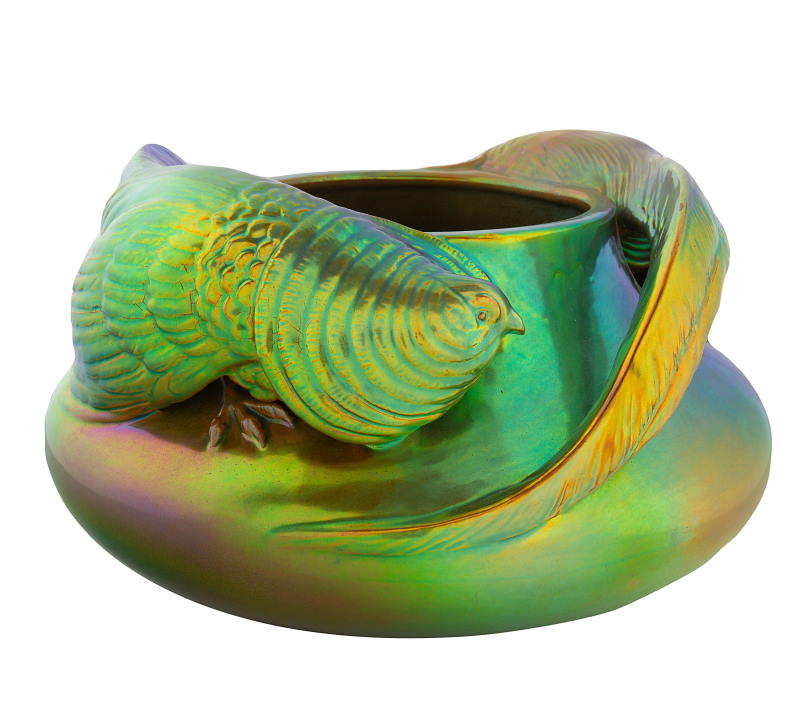
A Hungarian Eosin-Glazed Pheasant Vase Zsolnay Porcelain Factory Pecs Circa 1930 designed by Lajos Mack. Sold for $3,750 at Shapiro Auctions, July 2020. Another example of the natural and animal-inspired vases created by the Zsolnay factory is the “flower pot vase,” which was designed in the shape of a flower pot with a blooming flower emerging from the top. The vase was highly detailed and featured realistic textures and colors, creating a stunning and unique piece of art.
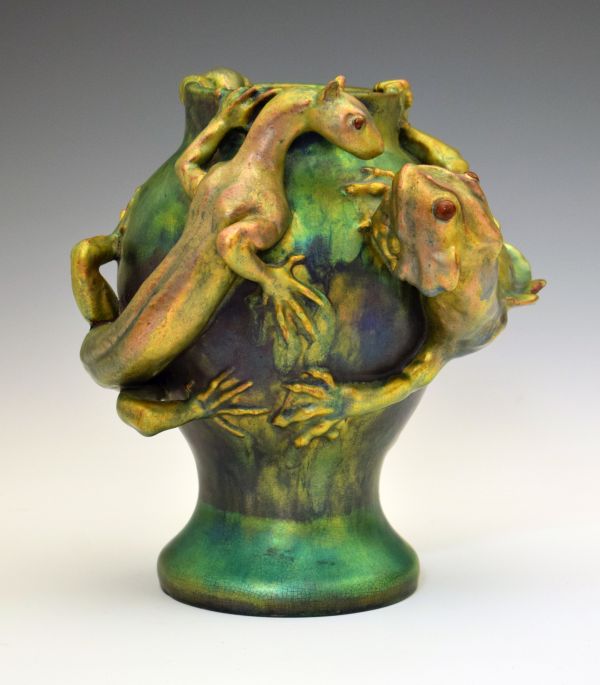
Zsolnay eosin glazed vase having figural decoration depicting two lizards, circa 1900. Sold for £4,000 at Clevedon Salerooms, June 2018. The Zsolnay factory also created vases in the shape of animals such as fish and birds, which were highly decorative and featured intricate details and vibrant colors. These vases were highly prized by collectors and art lovers of the time and remain highly sought after today.
One of the most unique features of the Zsolnay natural and animal-inspired vases was their use of innovative materials and techniques. For example, many of these vases were glazed using the eosin glaze, which gave them a striking iridescent sheen that changed color depending on the angle of the light. This technique was highly innovative for its time and added a new level of beauty and complexity to the natural and animal-inspired vases created by the Zsolnay factory.
- Architectural Ceramics
Pyrogranite, an innovative frost-resistant material, was developed by Zsolnay in 1886, opening up new possibilities for the company in the world of architectural ceramics. This groundbreaking material enabled Zsolnay to produce an array of ornamental ceramics that could withstand harsh weather conditions, making them perfect for exterior use. As a result, Zsolnay ceramics became a key feature in the architectural designs of the Art Nouveau movement.Budapest, the heart of Hungary, boasts a plethora of iconic monuments adorned with Zsolnay ornaments and tiles, reflecting the company’s profound impact on the city’s architectural landscape. Among the many notable buildings showcasing Zsolnay’s craftsmanship are the majestic Matthias Church, the awe-inspiring Hungarian Parliament Building, and the bustling Great Market Hall.
Zsolnay’s influence extends far beyond Hungary’s borders, as its distinctive ceramics can be found embellishing the facades of countless European buildings. This widespread presence is a testament to the unique beauty, durability, and artistry of Zsolnay ceramics, which have left an indelible mark on European architecture and design.
The Zsolnay Ceramics Factory is a testament to the rich artistic heritage of Hungary and the incredible talents of its designers and craftsmen. Today, the Zsolnay Ceramics Factory is still in operation, and it continues to produce high-quality ceramics using many of the same techniques and materials that made it famous in the 19th and early 20th centuries. The factory’s unique and striking glazes, including eosin, remain a testament to the skill and innovation of the Zsolnay family and their legacy in the world of ceramics.
Related
The Official Zsolnay Pottery web site





